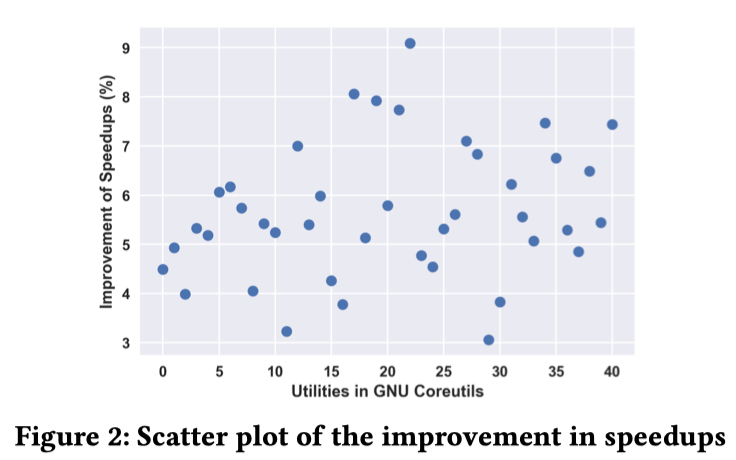UPDATED NEWS: FastKLEE has been accepted to the Tool Demonstrations Track of ACM Joint European Software Engineering Conference and Symposium on the Foundations of Software Engineering (ESEC/FSE 2022)!
FastKLEE is a tool that aims to speed up symbolic execution via reducing redundant bound checking of type-safe pointers. Two key insights behind FastKLEE are:
- The number of interpreted instructions tends to be stupendous (usually several billion only in one hour’s run)
- Only a small portion of pointers need bound checking during execution and reducing the interpreting overhead of most frequently interpreted ones (i.e., load/store instruction) could accelerate symbolic execution.
In terms of implementation, FastKLEE combines the notable type inference system Ccured and the well-known symbolic execution KLEE to perform faster symbolic execution.
Please kindly check out our video demonstration of FastKLEE.
The tool FastKLEE has been tested on Ubuntu 18.04 and hasn’t been tested on other platforms up to now, so Ubuntu 18.04 is preferred.
To install FastKLEE, users could execute
git clone https://github.com/haoxintu/FastKLEE
cd FastKLEE
./setup.sh
to set up both Ccured type inference system and the FastKLEE symbolic execution engine.
After installing the tool, copy the instrument file neschecklib.bc and the ccured analysis library libccured.so to the testing folder (examples/fastklee-test in this demo) and follow the following steps to perform testing.
For a single test program (e.g., test.c), users can get IR by executing
$clang -emit-llvm -c test.c -o test.bc
For more complex test programs (e.g., GNU Coreutils used in the paper), we recommend users to follow the official document from KLEE to get their IR code file.
Up to now, we assume users have obtained the test program and compiled it into IR code already. We take the cat test program in GNU Coreutils as an example to illustrate the core usabilities of FastKLEE.
Use the compiler tool-chain llvm-link to link the target program cat.bc and the instrumentation code neschecklib.bc together.
$cat run-instrumentation.sh
llvm-link cat.bc neschecklib.bc -o cat-linked.bc
$./run-instrumentation.sh
Use the compiler tool-chain opt to load libccured.so library and perform type inference analysis. This process will produce a text file cat-checklist.txt that records all the unsafe pointers in cat.bc. Such a checking list file will be used in the following process.
$cat run-type-inference-system.sh
opt -load libccured.so -nescheck -stats -time-passes < cat-linked.bc >& /dev/null
$./run-type-inference-system.sh
Now, users can run FastKLEE to perform faster symbolic execution. Users could also change the options (e.g., timeout) to set up different experiments for their own purpose.
$cat run-fastklee.sh
fastklee --simplify-sym-indices --write-cvcs --write-cov --output-module \
--max-memory=1000 --disable-inlining --optimize --use-forked-solver \
--use-cex-cache --libc=uclibc --posix-runtime \
--external-calls=all --only-output-states-covering-new \
--env-file=test.env --run-in-dir=/tmp/sandbox \
--max-sym-array-size=4096 --max-solver-time=30s --max-time=1min \
--watchdog --max-memory-inhibit=false --max-static-fork-pct=1 \
--max-static-solve-pct=1 --max-static-cpfork-pct=1 --switch-type=internal \
--use-batching-search --batch-instructions=10000 \
--search=dfs \
--output-dir="output-fastklee-cat" \
./cat.bc --sym-args 0 1 10 --sym-args 0 2 2 --sym-files 1 8 --sym-stdin 8 --sym-stdout
$./run-fastklee.sh
Note that the scripts used in this demo can be easily combined to be one to perform automated testing, we separate them when going through the demo only for the sake of the clear demonstration.
Evaluation results demonstrate that FastKLEE is able to reduce by up to 9.1% (5.6% on average) as the state-of-the-art approach KLEE in terms of the time to explore the same number (i.e., 10k) of execution paths.
The authors would like to thank all the developers who contribute to this tool and anonymous reviewers for their insightful comments.
@inproceedings{FastKLEE,
author = {Tu, Haoxin and Jiang, Lingxiao and Ding, Xuhua and Jiang, He},
title = {FastKLEE: Faster Symbolic Execution via Reducing Redundant Bound Checking of Type-Safe Pointers},
year = {2022},
booktitle = {Proceedings of the 30th ACM Joint European Software Engineering Conference and Symposium on the Foundations of Software Engineering},
pages = {1741–1745},
numpages = {5}
}
